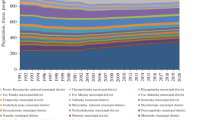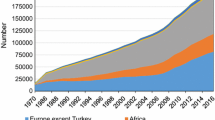Abstract
When Czechoslovakia was formed after World War I from the remains of the Austro-Hungarian Empire, the national boundaries imposed at the time did not accurately portray the areal extent of some ethnic groups. This was particularly true for the Hungarian minority which was established along the southern border of Slovakia. Because of this boundary arrangement, ethnic and economic divisions have resulted within Czechoslovakia and have continued in the new state of Slovakia. This paper analyzes the contemporary regional extent of the major ethnic groups in Slovakia at the district and commune levels. It also analyzes these ethnic patterns in light of a number of economic characteristics. Methods include mapping and analysis of various statistical tests using 1991 Czechoslovak census data. A strong relationship between Hungarian communes and agricultural employment is shown as well as a connection between employment in industry and Slovak ethnic regions. These findings suggest that the Hungarian minority has experienced a substantial geopolitical shift from the group in power to a peripheral society within Slovakia that continues to exhibit higher levels of agricultural reliance than the majority of ethnic Slovakian regions.
Similar content being viewed by others
References
Atlas Slovenskej Socialistickej Republickly, 1980: Slovenska Akademia View and Slovensky Urad Geodezie a Kartografie, Slovakia.
Bugajski J., 1994: The Fate ofMinorities in Eastern Europe. In: Diamond L. and Plattner M. F. (eds), Nationalism, Ethnic Conflict, and Democracy, pp. 102–116. The John Hopkins University Press, Baltimore.
Goldscheider C., 1995: Population, Ethnicity, and Nation-Building: Themes, Issues, and Guidelines. In: Goldscheider C. (ed.), Population, Ethnicity, and Nation-Building, pp. 1–17. Westview Press, Inc., Boulder.
HajdÚ Z., 1997: Emerging Conflict or Deepening Cooperation? The Case of the Hungarian Border Regions. In: Gangster P., Sweedler A., Scott J. and Dieter-Eberwein W. (eds), Borders and Border Regions in Europe and North America, pp. 193–211. San Diego State University Press, San Diego.
Hannan M.T., 1979: The dynamics of ethnic boundaries in modern states. In: Meyer J. W. and Hannan H.T. (eds), National Development and the World System: Educational, Economic, and Political Change, 1950–1970, pp. 253–275. University of Chicago Press, Chicago.
Ishiyama J.T. & Breuning M., 1998: Ethnopolitics in the New Europe. Lynne Rienner Publishers, Inc., Boulder.
Kocsis K. & Kocsis-Hodosi E., 1995: Hungarian Minorities in the Carpathian Basin: A Study in Ethnic Geography. Matthias Corvinus Publishing, Toronto.
Ley D., Peach C., & Clarke C., 1984: Introduction: Pluralism and human geography. In: Clarke C., Ley D. and Peach C. (eds), Geography & Ethnic Pluralism, pp. 1–22. George Allen & Unwin (Publishers) Ltd, London.
Machann C., 1990: The ethnic situation in Czechoslovakia after the revolution of November 1989. Journal of Ethnic Studies 18: 135–141.
Magocsi P.R., 1993: Historical Atlas of East Central Europe. University of Washington Press, Seattle.
Mather P.M. & Doornkamp J.C., 1970: Multivariate analysis in geography with particular reference to drainage-basin morphometry. Transactions, Institute of British Geographers 51: 163–188.
Mesaros J., 1991: Hungarian and Slovak history: a distorting mirror. The New Hungarian Quarterly 32: 98–102.
Mellor R. E. H., 1989: Nation, State, and Territory. Routledge, New York.
Perman D., 1962: The Shaping of the Czechoslovak State. E.J. Brill, Leiden, Netherlands.
Statistical Sciences, 1995: S-Plus Guide to Statistical and Mathematical Analysis, Version 3.3. StatSci, a division of MathSoft, Inc., Seattle.
Statistical Yearbook of the Slovak Republic, 1994: Statistical Office of the Slovak Republic President, Bratislava.
Tivey L., 1981: States, Nations and Economics. In: Tivey L. (ed.), The Nation-State, pp. 59–81. Martin Robertson, Oxford.
Author information
Authors and Affiliations
Rights and permissions
About this article
Cite this article
Otterstrom, S.M. Ethnic and economic regions in Slovakia: A statistical and visual exploration of contemporary patterns. GeoJournal 52, 139–147 (2000). https://doi.org/10.1023/A:1013377105057
Issue Date:
DOI: https://doi.org/10.1023/A:1013377105057




